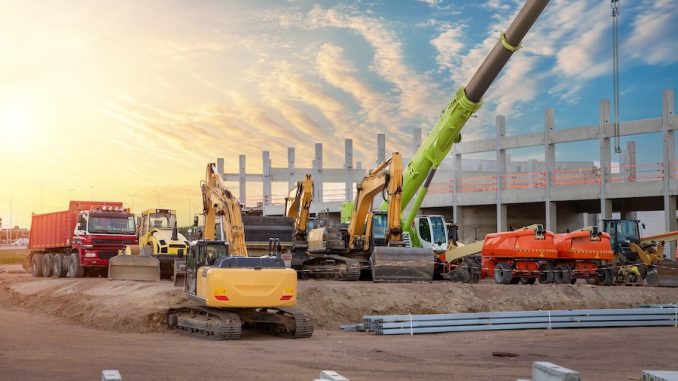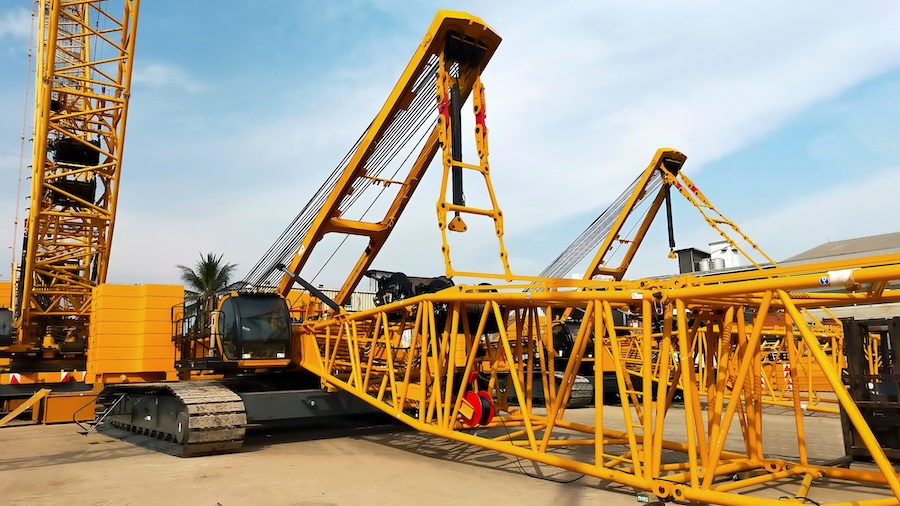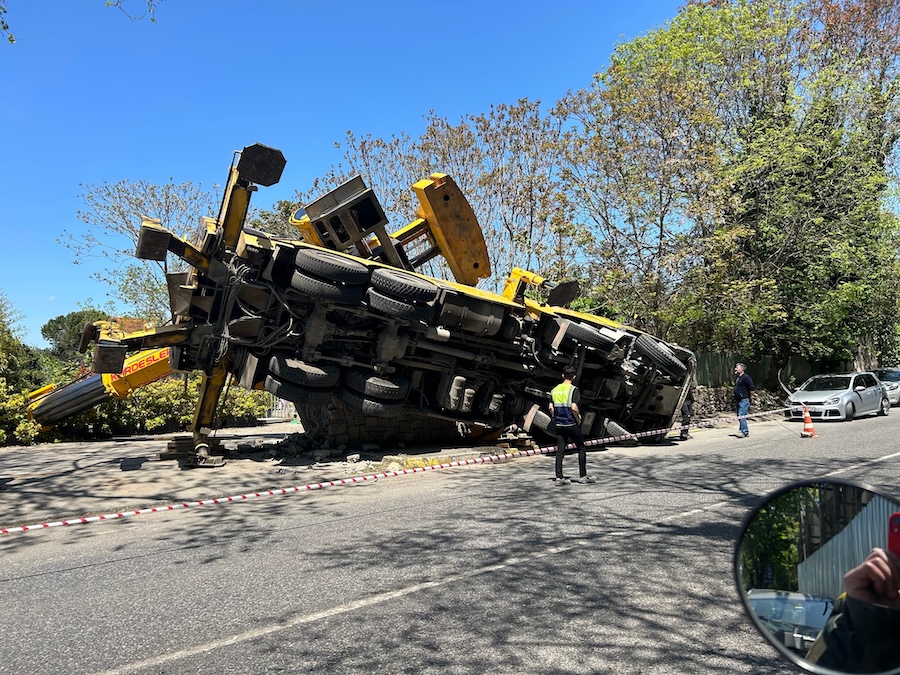
View the complete article here.
Whether you’re tackling a high-rise project or navigating the complexities of a sprawling construction site, choosing the right crane is crucial for success. In this guide—we’ll walk you through the different types of cranes available, how to assess your rental needs based on your project’s specifics, and what to consider when selecting a crane rental company. Plus, we’ll offer practical tips on managing costs and ensuring safety—helping you make informed decisions that optimize efficiency on your construction projects.
Understanding Different Types of Cranes
In construction, various types of cranes play a pivotal role—enabling the movement and placement of large and heavy materials. Each type of crane is designed with specific scenarios in mind, making it essential for contractors to understand the distinctions to select the appropriate crane for their projects.
Tower cranes are a common fixture at urban construction sites, especially in high-rise building projects. These cranes are anchored to the ground on a concrete slab, soaring hundreds of feet into the air with a jib extending from the mast. They are known for their high lifting capacity and are particularly useful in confined spaces and can remain on-site for extended periods.
Mobile cranes are valued for their versatility and mobility, mounted on wheels or caterpillar tracks to facilitate easy movement across a site or between sites. This type of crane includes a range from small truck-mounted cranes to large all-terrain models, known for quick setup and flexibility in movement and positioning. They are particularly useful for projects that require multiple lifting locations, such as residential buildings or projects with spread-out structures.
Crawler cranes, which are mounted on an undercarriage with a set of tracks (or crawlers), provide excellent stability and mobility. These cranes are capable of moving across soft ground without the risk of sinking and are known for their substantial lifting capacity, typically higher than that of tire-equipped cranes. Crawler cranes require no setup of outriggers, making them ideal for large-scale construction projects on uneven or soft terrain—such as bridges and power stations.
Rough-terrain cranes are designed for off-road applications—featuring large, rugged tires and a compact build to navigate tough terrains. With capabilities like four-wheel drive and steering, they excel in maneuverability on uneven surfaces and are quick to set up with telescopic booms. These cranes are best suited for construction in challenging terrains like rural areas or sites with problematic ground conditions.

Assessing Crane Rental Needs
Before renting a crane, contractors must carefully assess several crucial factors to ensure they choose the right equipment for their projects. These factors include the project size, duration, budget, and specific lifting needs—each playing a vital role in the decision-making process.
Project size directly influences the type of crane required. Larger projects may necessitate cranes with higher capacity and longer reach—while smaller projects could be adequately served by lighter, more mobile cranes. Understanding the scope of the project helps in selecting a crane that can handle the required loads without underutilization or excessive costs.
Project duration is another critical factor. For short-term projects, renting a crane may be more cost-effective than purchasing—especially for specialized or infrequently used equipment. However, for long-term projects, the cost-benefit analysis might lean towards longer leases or even purchasing—depending on the financial implications and usage frequency.
Budget constraints can significantly affect the type of crane and rental agreement terms. Contractors need to balance the need for a suitable crane with the available budget—considering not only the rental cost but also transportation, setup, operation, and insurance expenses. A detailed budget plan helps avoid unexpected costs and ensures that the crane rental fits within the financial framework of the project.
Specific lifting needs such as weight, height, and the radius of the loads dictate the crane’s specifications. Contractors must consider what materials will be lifted and the environment in which the crane will operate. Factors like wind conditions, the ground’s stability, and space constraints can impact crane performance and safety.
In addition to these factors, project planning and site assessment are indispensable. Proper planning ensures that the crane’s deployment aligns with project timelines and site logistics. Conducting a thorough site assessment before renting a crane identifies potential hazards and logistical challenges, ensuring the selected crane can operate safely and efficiently. This assessment should consider access routes for delivering the crane, space for operation, and site conditions.
Choosing a Reliable Crane Rental Company
Selecting the right crane rental company is as crucial as choosing the appropriate crane. The reliability and expertise of the rental company can significantly influence the success of a project. Here are the key criteria to consider and tips on negotiating rental contracts to ensure favorable terms.
Criteria for Selecting a Rental Company
The reputation of a crane rental company is a strong indicator of its reliability and service quality. A company with a solid reputation is likely to have a proven track record of fulfilling client expectations and handling complex lifting needs effectively.
High service quality includes timely deliveries, responsive customer service, and flexible rental terms. The ability to support clients throughout the rental period, providing technical advice and immediate problem resolution, adds value beyond the basic rental agreement.
Regularly maintained and serviced cranes are less likely to encounter operational failures. Before choosing a rental company, inquire about their maintenance practices and review their equipment service logs. This ensures the cranes are in optimal working condition, reducing downtime and safety risks.
Some rental companies offer the option to hire cranes with or without an operator. When operators are available, it’s important to ensure they are certified and have experience with the specific type of crane you plan to rent. Trained operators can significantly enhance safety and efficiency on the job site.
Effective customer support is essential, especially when unexpected issues arise. A rental company that offers robust support can help mitigate any problems quickly, minimizing any impact on project timelines.
Tips on Negotiating Rental Contracts
Before entering negotiations, clearly define what you need from the rental—including the type of crane, rental duration, and additional services like transportation and setup. This clarity will help you negotiate terms that match your project requirements.
Request detailed quotes from multiple rental companies. Compare not only the prices but also what is included in those prices—such as maintenance, insurance, and operator fees. This comparison will give you a stronger negotiating position.
Use the information from your quotes to negotiate terms that benefit your project. Discuss areas such as payment terms, cancellation policies, and penalties for early termination or extended rental periods.
Projects can change unexpectedly. Negotiate clauses that allow for adjustments in the rental period or the type of crane, which can be crucial if project scopes expand or shift.
Ensure that all terms, conditions, and costs are clearly outlined in the contract. Transparency prevents disputes and hidden charges, contributing to a smoother rental experience.

Safety and Compliance
Ensuring safety and compliance is paramount in crane operations, not only to protect personnel and property but also to adhere to legal requirements.
Overview of Safety Regulations and Compliance Requirements
Operating cranes involves strict adherence to safety regulations and compliance requirements that vary by region but generally include guidelines on equipment operation, maintenance, and inspections. These regulations are enforced to minimize risks associated with crane operations—such as mechanical failures, overloading, and accidents due to operator error. Contractors must familiarize themselves with OSHA standards (or equivalent local regulations)—which cover aspects like crane setup, operation, and necessary documentation to ensure compliance and safety on the construction site.
Importance of Crane Operator Certifications and the Role of Training
Crane operator certifications are not just formalities but essential requirements that affirm the operator’s ability to handle heavy machinery safely and effectively. Certified operators have undergone rigorous training to understand crane mechanics, operational techniques, and safety protocols. Continuous training is crucial, too—as it helps operators stay updated with new technologies, safety practices, and regulatory changes. Employing certified and well-trained operators significantly reduces the risk of accidents and increases operational efficiency.
Pre-rental Inspection Checklist to Ensure Crane Safety and Readiness
Before accepting a crane from a rental company, it’s advisable to conduct a thorough pre-rental inspection. This inspection should ensure that the crane is in optimal working condition and complies with all safety standards. Here is a basic checklist to guide this inspection:
- Structural integrity: Check for any signs of wear or damage on the crane’s body and its components.
- Mechanical and electrical systems: Verify that all mechanical parts, such as the engine and hydraulics, are functioning correctly. Electrical systems, including emergency shut-offs and alarms, should also be tested.
- Safety features: Ensure all safety features—such as load indicators, limit switches, and brakes—are operational.
- Documentation: Check for up-to-date inspection certificates and maintenance logs. This documentation provides a history of the crane’s upkeep and compliance with safety standards.
- Operator manuals and load charts: Ensure these are available and reviewed. They are crucial for safe and efficient operation.
Cost Considerations
Managing the costs associated with renting a crane is crucial for maintaining budget discipline and ensuring project profitability.
Breakdown of Rental Costs
Crane rental costs can vary widely based on the type of crane, the length of the rental period, and regional market conditions. Typically, rental companies offer different rates based on the rental duration:
- Daily rates are usually higher on a per-day basis and are suitable for short-term projects that last a few days.
- Weekly rates are discounted compared to daily rates and are ideal for projects that span several weeks.
- Monthly rates offer the best value for long-term projects, as they are significantly lower per day compared to daily and weekly rates.
It’s important for contractors to estimate the duration of their needs as accurately as possible to choose the most cost-effective rental period.
Hidden Costs to Be Aware Of
Several hidden costs can affect the total expenditure on crane rentals, such as:
- Transportation: The cost to deliver and return the crane can be substantial, especially for heavy or large cranes that require special transport arrangements.
- Setup/Takedown: Some cranes, particularly tower cranes, involve complex and time-consuming setups and takedowns—which can add to the costs.
- Operator fees: If a crane is rented with an operator, the fees for the operator are additional and can vary based on their expertise and the crane type.
- Insurance: Renting a crane typically requires insurance to cover potential damage to the crane, property, or third-party liability—which can be a significant part of the cost.
View the complete article here.
What types of cranes are available for rental?
Cranes available for rental include tower cranes, mobile cranes, crawler cranes, and rough-terrain cranes.
What should I consider when choosing a crane rental company?
Consider the company's reputation, service quality, equipment maintenance, operator availability, and customer support.













































